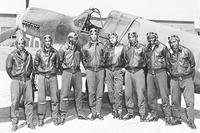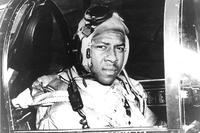Joseph V. Micallef is a best-selling military history and world affairs author, and keynote speaker. Follow him on Twitter @JosephVMicallef.
The Battle for the Atlantic was the longest-running theater of World War II. It began on Sept. 1, 1939, the first day of the war. It would continue until the very last day of the European theater, May 7, 1945, when Germany surrendered.
Indeed, some German submarines operating in the Atlantic did not receive notice of Germany's surrender until several days after it had gone into effect and continued operations until then. The war in the Atlantic would include more than 100 convoy battles and approximately 1,000 ship-to-ship encounters.
The principal issue in the Atlantic Theater was whether German surface ships and submarines could cut Great Britain's Atlantic lifeline. Britain was dependent on its seaborne trade to be able to continue its war effort. Moreover, a successful Allied invasion of France would require millions of U.S. soldiers, their equipment and millions of tons of supplies to be transported safely across the Atlantic.
Germany's surface ships, the so-called surface raiders, proved to be largely ineffective and were quickly sunk by the Royal Navy or were withdrawn to protected waters. Germany's submarine fleet, however, proved to be much more formidable.
Operating singly and then in groups nicknamed wolfpacks, they sank the majority, 2,825, of the 3,500 merchant ships, totaling 14.5 million tons of Allied shipping lost during the course of the war in the Atlantic. At its peak in November 1942, German submarines sank 142 ships, with a combined capacity of more than 700,000 tons. The Allies lost more ships in May and June of 1942, 146 ships per month, but the total tonnage was less than in November.
Some contemporary historians have argued that the U-boat threat to Great Britain was exaggerated. After the U.S. joined the war, U-boats would have needed to sink an average of 700,000 tons of shipping capacity per month to pose a serious threat to Great Britain -- a target they hit only once. After 1943, new ship construction in the U.S. was more than enough to make up the losses from U-boats in the Atlantic. During WWII the Allies built more than 38 million tons of new shipping capacity.
The principal weaknesses in the Allied strategy in the Atlantic were a lack of surface escorts and, in particular, air cover, for the convoys. The gap in air coverage, termed the mid-Atlantic gap, was roughly in the longitudes between Greenland and Iceland. Convoys were particularly vulnerable to attack in this part of the central Atlantic and had to rely on surface escorts for defense against submarines.
Enter Geoffrey Pyke, an eccentric British inventor, who had been put on the staff of Combined Operations by its head, Lord Louis Mountbatten. Combined Operations was a department in the War Office tasked with staging raids by a combination of navy and army forces on the European continent to harass the Germans.
Pyke suggested in a memorandum to Mountbatten the use of large floating ice islands, either naturally made or artificially constructed, to serve as floating airfields in the mid-Atlantic. The islands would be used to stage air forces to provide air cover to convoys in the central Atlantic gap. Pyke also suggested that such floating ice platforms could be utilized as staging platforms for amphibious assaults on France or Japan.
The Admiralty considered the possibility of detaching large blocks of the polar ice cap and positioning them in the North Atlantic. The Royal Navy's Fleet Air Arm determined that a floating ice island would require a runway at least 2,000 feet long and roughly 100 feet wide to allow normally land-based fighters and bombers to safely land and take off. Moreover, the ice island would need to have a freeboard of at least 50 feet to ensure that the airstrip would not be inundated by the Atlantic's swells. Since floating ice has 90 percent of its mass under water, an ice island with a freeboard of 50 feet would require a chunk of ice 500 feet thick. The polar ice caps are only 10 to 15 feet in thickness.
Greenland's ice sheet had sufficient thickness, but cutting off a piece that had the necessary dimensions would be extremely difficult. An iceberg might work if it had a sufficiently large surface area, but icebergs were unstable and prone to flipping over. A chunk of the Antarctic ice shelf could have worked, but towing an ice island all the way from Antarctica was deemed impractical.
Pyke had also stumbled across some research indicating that ice formed by mixing water with 10-15 percent wood pulp created a substance much stronger than normal ice and comparable to concrete in strength. Further tests conducted at a shop in the Smithfield Market in London confirmed the results and demonstrated that as little as 4 percent wood pulp was sufficient. The material was originally called picolite, but the name was later changed to pykrete.
According to an oft-repeated story, Mountbatten took a block of pykrete to Winston Churchill and put it in his bathtub while he was bathing. The outer layer of the block melted but, once the hot water reached the wood pulp, the block was effectively insulated from the bath water. Impressed by the demonstration, Churchill ordered Mountbatten to draw up plans for a giant aircraft carrier made from pykrete and to present the plan at the upcoming Quebec Conference. The plan was dubbed Project Habakkuk.
Mountbatten repeated the demonstration at the Quebec conference in August 1943. This time, he brought two blocks of ice, one of normal ice and the other made from pykrete, and challenged the U.S. officers at the meeting to break the ice with a single blow of an ice chopper.
Gen. Hap Arnold, commander of the U.S. Army Air Forces, deemed the strongest by his fellow officers, was able to cut through the ice with a single blow. He was unable to cut through the block of pykrete, despite repeated attempts. To underscore his point, Mountbatten then shot a bullet into the pykrete from his service revolver. The bullet bounced off, ricocheted around the room and grazed the leg of Adm. Ernest King, chief of U.S. naval operations. The incident prompted security personnel to rush into the meeting, believing that one of the officers had started shooting the others.
Project Habakkuk envisioned a ship in the shape of a hollow square beam with beveled edges. It would be 2,000 feet long and 98 feet wide. The hull would be 30 feet thick, making it impervious to bombs and torpedoes, and have a draft of 148 feet. The ice ship would have a total displacement of roughly 2.2 million tons. By comparison, a Nimitz-class aircraft carrier has a displacement of around 100,000 tons.
The ice ship could have carried up to 150 twin-engine bombers or fighters. It would be powered by 26 electric motors mounted on separate external nacelles. The 33,000 horsepower/25,000 kw needed to power the ship would have been supplied by steam turbo-generators. Steering was to be accomplished by altering the speed of the electric motors. At one point, the Royal Navy decided it would need a separate rudder, but the issue of how to mount and operate a rudder was never resolved.
The ship would be covered by an insulating skin of fiberboard, designed to slow down its melting. Further tests determined that pulp from Canadian spruce trees was best as it showed the lowest amount of deformation in the ice structure, what glaciologists call creep or cold flow, over time. Airplane hangers and crew quarters would be carved out of the ice and insulated. Runways would be built out of wood or concrete brick.
Pyke also suggested that such ships could be used to carry cargo across the Atlantic to Great Britain. The proposed ship would have a capacity of one million tons of cargo. A Liberty ship could carry around 10,000 tons, so an ice ship would have the capacity of 100 Liberty ships. There was no dock in the world big enough to accommodate an ice ship, so it would have to remain anchored off shore and be loaded and unloaded by smaller ships.
A smaller, prototype ice ship, measuring 60 feet by 30 feet and displacing 1,000 tons, was built as a scale model at Patricia Lake in Alberta, Canada. It was decided that the ship would be built in Canada, off the east coast, and then be towed to a station in the central Atlantic. The proposed ship would require 300,000 tons of wood pulp, 25,000 tons of fiberboard insulation, 35,000 tons of timber and 10,000 tons of steel. Miles of steel tubing would have to be imbedded into the hull in order to refrigerate it by running cold air through them. The original cost was estimated at approximately $1 million -- roughly $14.5 million today. Subsequent design changes, such as a requirement that the ship be able to handle heavy bombers and that the flight deck be at least 10 feet above the worst Atlantic swells ever recorded, led to a sharp increase in the amount of materials required and more than tripled the expected construction cost.
The design changes, as well as a number of technical issues, pushed the construction date of the ice ship into 1945. But by 1944, it was already clear that the ship would not be needed. Several different factors solved the specific problem of air coverage in the mid-Atlantic gap and the more general threat posed by German U-boats.
First, a British agreement with Portugal in August 1943 allowed for the use of air bases in the Azores for anti-submarine patrols. In November 1944, the U.S. also signed an agreement with Portugal for air bases in the Azores.
Second, the U.S. was well on its way to ramping up its production of aircraft carriers. A total of 151 carriers were built during WWII, 122 of which were escort carriers. Many of the light (CVL) and escort (CVE) carriers built were tasked with convoy escort in the Atlantic. Moreover, the deployment of Navy blimps to spot submarines for destroyer escorts, as well as the development of long-range aircraft, such as the Very Long Range (VLR) Liberators for anti-submarine warfare (ASW) patrols, eliminated the lack of coverage in the central Atlantic.
Thirdly, the deployment of, comparatively speaking, inexpensive corvettes improved convoy defense, as did the deployment of SONAR and improved ASW weapons such as the "Hedgehog" and, later, "Squid" depth charge.
The ice ship was never built, but the technology remains viable should the U.S. ever need a floating ice island from which to conduct military operations. NASA has also considered pykrete as a possible building material on Mars and other alien worlds. Unlike its WWII counterpart, however, in an age of nuclear weapons, the prospect of an unsinkable ship has long since become obsolete.
-- The opinions expressed in this op-ed are those of the author and do not necessarily reflect the views of Military.com. If you would like to submit your own commentary, please send your article to opinions@military.com for consideration.















